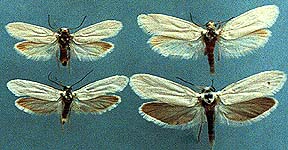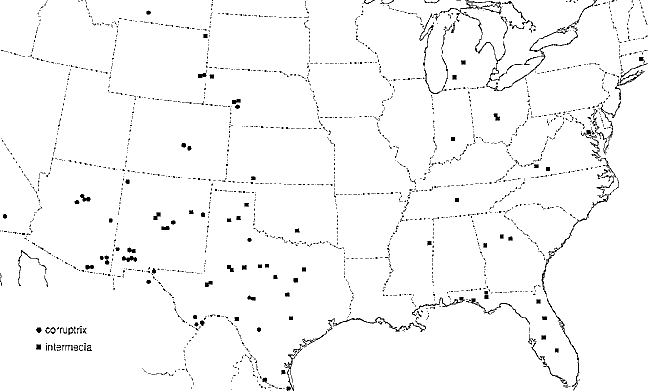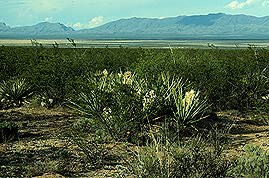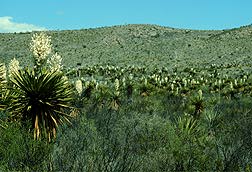Tegeticula corruptrix
Olle PellmyrAdult Characteristics
Wing expanse 22.5-35 mm. Forewing white or occasionally more or less tan colored (at higher elevation); hindwing uniformly dark brown, or darker brown along front edge and near apex, gradually lighter due to sparser scaling toward back corner. Female with reduced maxillary tentacles. Male genitalia with aedeagus 2.2-2.8 mm long, 0.06-0.08 mm in cross section; female genitalia with posterior apophyses 9.0-12.9 mm long, corpus bursae with signa 0.5-1.0 mm in diameter.
Comparison with Similar Species
This very large non-pollinating species, approached in size only by superficiella and elatella, is readily distinguished by the reduced tentacles in the female. Internally quite variable, and more than one good species may be covered under this name. Genitalia are highly characteristic for identification; a diagnostic key is provided.
Host, Oviposition, and Larval Feeding Habits
The species is known from the fleshy-fruited Yucca baccata, Y. treculeana (Y. torreyi), Y. schidigera and the capsular-fruitedY. glauca, Y. baileyi, including var. intermedia, Y. elata (Y. verdiensis). (Pellmyr 1999). Females oviposit into full-size fruit, laying eggs directly into developed seed. The larva feeds on developing seeds. Pupation occurs in a cocoon in the soil.
Geographic Distribution
Documented from southwestern California, Arizona, New Mexico, northern Coahuila, western and southernmost Texas, Colorado, and the westernmost Plains of Nebraska, Wyoming, and Montana.
Habitat
Typical habitat includes grasslands, shrub desert, rocky hillsides, open pine forest, and shrubby grassland. Altitudinal range 0-2300 m
References
Pellmyr, O. 1999. Systematic revision of the Tegeticula yuccasella complex (Lepidoptera: Prodoxidae) north of Mexico. Systematic Entomology 24:243-271.
Title Illustrations

| Scientific Name | Tegeticula corruptrix |
|---|---|
| Location | Grant Co, New Mexico, USA; Brewster Co, Texas, USA; Stillwater Co, Montana, USA |
| Specimen Condition | Dead Specimen |
| Sex | males (left), females (right) |
| Image Use |
 This media file is licensed under the Creative Commons Attribution-NonCommercial License - Version 3.0. This media file is licensed under the Creative Commons Attribution-NonCommercial License - Version 3.0.
|
| Copyright |
© 1996
Olle Pellmyr

|
About This Page
Olle Pellmyr

University of Idaho, Moscow, Idaho, USA
Page copyright © 1996 Olle Pellmyr
 Page: Tree of Life
Tegeticula corruptrix .
Authored by
Olle Pellmyr.
The TEXT of this page is licensed under the
Creative Commons Attribution-NonCommercial License - Version 3.0. Note that images and other media
featured on this page are each governed by their own license, and they may or may not be available
for reuse. Click on an image or a media link to access the media data window, which provides the
relevant licensing information. For the general terms and conditions of ToL material reuse and
redistribution, please see the Tree of Life Copyright
Policies.
Page: Tree of Life
Tegeticula corruptrix .
Authored by
Olle Pellmyr.
The TEXT of this page is licensed under the
Creative Commons Attribution-NonCommercial License - Version 3.0. Note that images and other media
featured on this page are each governed by their own license, and they may or may not be available
for reuse. Click on an image or a media link to access the media data window, which provides the
relevant licensing information. For the general terms and conditions of ToL material reuse and
redistribution, please see the Tree of Life Copyright
Policies.
Citing this page:
Pellmyr, Olle. 1996. Tegeticula corruptrix . Version 01 January 1996 (under construction). http://tolweb.org/Tegeticula_corruptrix/12470/1996.01.01 in The Tree of Life Web Project, http://tolweb.org/











 Go to quick links
Go to quick search
Go to navigation for this section of the ToL site
Go to detailed links for the ToL site
Go to quick links
Go to quick search
Go to navigation for this section of the ToL site
Go to detailed links for the ToL site